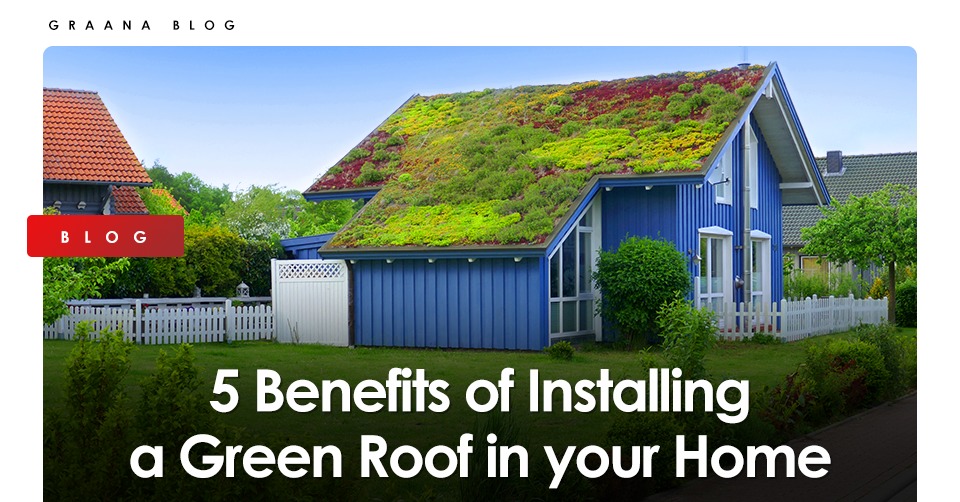
Rooftop gardens are an excellent way to turn an urban landscape into a haven. Rooftop gardens are a technique to bring nature into a sterile environment for commercial buildings. A rooftop garden can be a solution, and a means to provide a place to relax or cultivate plants and vegetables to promote a sustainable lifestyle for a resident that does not have a backyard or have limited space. Landscape architects are pushing boundaries to find ways to increase green space while lowering energy usage, and they’ve discovered the many advantages of a green roof. Graana.com explains the importance and benefits of installing a green roof in your homes.
A rooftop garden can be desired for merely aesthetic or practical reasons, such as providing space for a communal garden, farming, or as an environmentally beneficial way to cool your home and save money on energy expenses.
Green roofs are helpful for more than just aesthetics: they also serve a practical purpose.
The benefits of installing Green Roof in home are as follows
The Plants on a green roof clean the air, produce oxygen and give shade. Furthermore, green roofs can endure twice as long as standard rooftops because of this natural protection from high heat.
Green roofs aid in the reduction of the Urban Heat Island Effect, a phenomenon in which cities absorb and retain heat.
Unlike standard black tar roofs, Green roofs save energy by absorbing rather than attracting heat and providing natural insulation for structures. According to the National Research Council of Canada, even just a six-inch-wide green roof can lower summer energy demands by more than 75%. Green roofs reduce the generation of atmospheric air pollution and greenhouse gas emissions by lowering air conditioning demand.
Green roofs can also reduce and moderate stormwater flow in urban areas, which is an essential benefit. Because city rooftops and roadways are hard surfaces, stormwater runoff volume and velocity rise dramatically, and it is a significant source of flooding and pollution around the world.
A typical city block generates more than five times the runoff of a comparable woodland area due to nonporous surfaces like pavement and rooftops. The ability of a green roof to absorb (and filter) water reduces the risk of flash flooding and sewer overflows dramatically. Green roofs may retain up to 90% of the precipitation that falls on them in the summer and 40% in the winter.
Despite its numerous advantages, the upfront cost is a significant barrier. Green roofs are usually two to three times more expensive than non-green roofs. Although green roofs are not accessible or inexpensive to install, many communities have realised that the long-term advantages outweigh the upfront costs. New York City, for example, has a pilot program that offers tax exemptions to encourage the development of green roofs. Roof gardens may become more common in the future if more cities follow the same trend.
For ages, the Scandinavian countries have used them. They were first introduced in Germany in the 1960s, and they now account for roughly 10% of all roofs in the country. Copenhagen made the smart decision to make them mandatory to achieve CO2-free emissions by 2025. Green roofs have emerged as an effective means of reducing CO2 emissions into the environment from cities to manage their temperature, so lowering air-conditioning or heating costs and, as a result, increasing the quality of life for their citizens.
Although a rooftop garden is more expensive than a typical garden, it quickly pays for itself. You will be rewarded with a significant reduction in energy usage and electricity costs, as well as an overall gain in quality of life, whether you create a rooftop garden for pleasure or practical reasons. The long-term benefits surpass the initial installation expenses, giving an environmentally beneficial approach to bring nature into an urban setting and a more sustainable solution for high-density living. Get to know heat resistance sheets for roof.
Dubai’s residential real estate market maintained its upward momentum in November 2025, with the latest…
Saudi Arabia’s Real Estate General Authority (REGA) has announced the launch of a new platform…
Dubai: Tomorrow World Group, a global enterprise with a 20-year presence in the emirate, has…
Islamabad: The Capital Development Authority has begun a citywide rehabilitation and upgrading campaign, starting…
Dubai: The emirate’s real estate sector continued its strong performance in November 2025, posting transactions…
The 19th Real Estate Development Summit Saudi Arabia Luxury Edition ended after two days of…